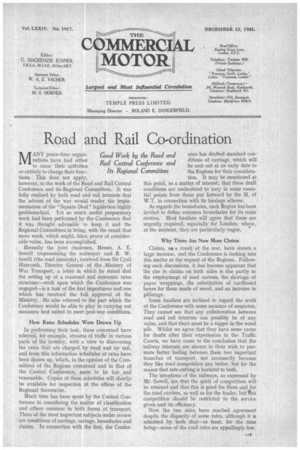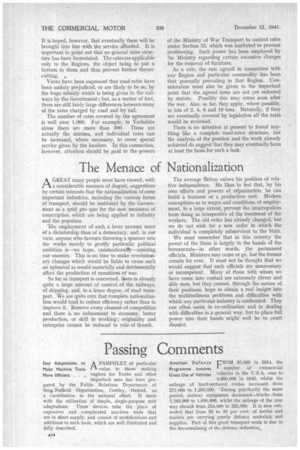Road and Rail Co-ordination
Page 15

Page 16

If you've noticed an error in this article please click here to report it so we can fix it.
MANY peace-time organizations have had either to cease their activities or entirely to change their functions. This does not apply, however, to the work of the Road and Rail Central Conference and its 'Regional Committees. It was fully realized by both road and rail interests that the 'advent of the war would render, the implementation of the "Square Deal " legislation highly problematical. Yet so much useful preparatory work had been performed by the Conference that it was thought advisable to keep it and the Regional Committees in being, with the result that more work, which might, later, prove of considerable value, has been accomplished.
Recently the joint chairmen, Messrs. A. E. Sewell (representing the railways) and R. W. Sewill (the road interests), received from Sir Cyril Hurcomb, Director General of the Ministry of War Transport, a letter in which he stated that the setting up of a reasoned and economic rates structure—work upon which the Conference was engaged—is a task of the first importance and one which has received the full approval, of the Ministry. He also referred to the part which the Conference would be able to play in carrying out measures best suited to meet post-war conditions.
How Rates Schedules Were Drawn Up In performing their task, those concerned have seIe-cted, for example, streams of traffic in various parts of the country, with a view to discovering the rates that are charged by road and by rail, and from this information schedules of rates have been drawn up, which, in the opinion of the Committees of the Regions concerned and in that of the Central Conference, seem to be fair , and reasonable. Copies of these schedules will shortly be available for inspection at the offices of the Regional Secretaries.
Much time has been spent by the Central Conference in considering the matter of classification and others common to both forms of transport. Three of the most important subjects under review are conditions of carriage, cartage, boundaries and claims. In connection with the first, the Confer once has drafted standard conditions of carriage, which will be sent out at an early date to the Regions for their consideration. It may be mentioned at this point, as a matter of interest, that these draft conditions are understood to vary in some essential points from those put forward by the M. of W.T. in connection with its haulage scheme.
As regards the boundaries, each Region has been invited to define common boundaries for its main centres. Most hauliers will agree that these are urgently required, especially for London, where, at the moment, they are particularly vague.
Why There Are Now More Claims Claims, a a result of the war, have shown a larxe increase, and the Conference is looking into this matter at the request of the Regions. Following such discussions, it has become apparent that the rise in claims, on both sides is due partly to the employmeJat of used cartons, the shortage of paper wrappings, the substitution of cardboard boxes for those made of wood, and an increase in pilferage.
Some hauliers are inclined to regard the work of the Conference with some measure of suspicion. They cannot see that any collaboration between road and rail interests can possibly be of any value, and that there must be a nigger in the wood pile. Whilst we agree that they have some cause for doubt after their experiences in the Traffic Courts, we have come to the conclusion that the railway interests are sincere in their wish to promote better feeling between these two important branches of transport, not necessarily because they like road competition any better, but for the reason that rate-cutting is harmful to both.
The intentions of the railways, as expressed by Mr. Sewell, are that the spirit of competition will be retained and that this is good for them and for the road carriers, as well as for the trader, but this competition should be restricted to the service given and its efficiency.
Now the two sides have reached agreement despite the disparity of some rates, although it is admitted by both that—at least, for the time being—some of the road rates are appallingly low. It is hoped, however, that eventually these will be brought into line with the service afforded. It is important to point out that no general rates structure has been formulated. The rates are applicable only to the Regions, the object being to put a bottom to them and thus prevent further throatcutting.
Views have been expressed that road rates have been unduly prejudiced, or are likely to be so, by the huge subsidy which is being given to the railways by the Government ; but, as a matter of fact, there are still fairly large differences between many of the rates charged by road and by rail.
The number of rates covered by the agreement is well over 1,000. For example, in Yorkshire alone there are more than 300. These are actually the minima, and individual rates can be increased, where necessary, to cover special service given by the hauliers. In this connection, however, attention should be paid to the powers of the Ministry of War Transport to control rates under Section 55, which was instituted to prevent profiteering. Such power has been employed by the Ministry regarding certain excessive charges for the removal of furniture. • As a rule, the rate agreed in connection with any Region and particular commodity has been that generally prevailing in that Region. Consideration must also be given to the important point that the agreed rates are not yet enforced by statute. Possibly this may came soon after the war. Also, so far, they apply, where possible, to lots of 2, 4, 6 and 10 tons. Naturally, if they are eventually covered by legislation all the rates would be reviewed.
There is no intention at present to found anything like a complete road-rates structure, but the analysis of the position and the work already achieved do suggest that they may eventually form at least the basis for such a task.




















































